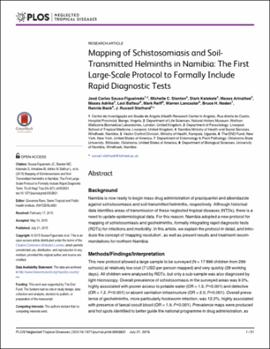| dc.contributor.author | Sousa-Figueiredo, Jose Carlos | |
| dc.contributor.author | Stanton, Michelle C. | |
| dc.contributor.author | Katokele, Stark | |
| dc.contributor.author | Arinaitwe, Moses | |
| dc.contributor.author | Adriko, Moses | |
| dc.contributor.author | Balfour, Lexi | |
| dc.contributor.author | Reiff, Mark | |
| dc.contributor.author | Lancaster, Warren | |
| dc.contributor.author | Noden, Bruce H. | |
| dc.contributor.author | Bock, Ronnie | |
| dc.contributor.author | Stothard, J. Russell | |
| dc.date.accessioned | 2022-04-12T13:52:13Z | |
| dc.date.available | 2022-04-12T13:52:13Z | |
| dc.date.issued | 2015-07-21 | |
| dc.identifier | oksd_noden_mappingofschistosomiasis_2015 | |
| dc.identifier.citation | Sousa-Figueiredo, J. C., Stanton, M. C., Katokele, S., Arinaitwe, M., Adriko, M., Balfour, L., ... Stothard, J. R. (2015). Mapping of schistosomiasis and soil-transmitted helminths in Namibia: The first large-scale protocol to formally include rapid diagnostic tests. PLoS Neglected Tropical Diseases, 9(7), Article e0003831. https://doi.org/10.1371/journal.pntd.0003831 | |
| dc.identifier.uri | https://hdl.handle.net/11244/335184 | |
| dc.description.abstract | Background: Namibia is now ready to begin mass drug administration of praziquantel and albendazole against schistosomiasis and soil-transmitted helminths, respectively. Although historical data identifies areas of transmission of these neglected tropical diseases (NTDs), there is a need to update epidemiological data. For this reason, Namibia adopted a new protocol for mapping of schistosomiasis and geohelminths, formally integrating rapid diagnostic tests (RDTs) for infections and morbidity. In this article, we explain the protocol in detail, and introduce the concept of 'mapping resolution', as well as present results and treatment recommendations for northern Namibia. | |
| dc.description.abstract | Methods/Findings/Interpretation: This new protocol allowed a large sample to be surveyed (N = 17 896 children from 299 schools) at relatively low cost (7 USD per person mapped) and very quickly (28 working days). All children were analysed by RDTs, but only a sub-sample was also diagnosed by light microscopy. Overall prevalence of schistosomiasis in the surveyed areas was 9.0%, highly associated with poorer access to potable water (OR = 1.5, P<0.001) and defective (OR = 1.2, P<0.001) or absent sanitation infrastructure (OR = 2.0, P<0.001). Overall prevalence of geohelminths, more particularly hookworm infection, was 12.2%, highly associated with presence of faecal occult blood (OR = 1.9, P<0.001). Prevalence maps were produced and hot spots identified to better guide the national programme in drug administration, as well as targeted improvements in water, sanitation and hygiene. The RDTs employed (circulating cathodic antigen and microhaematuria for Schistosoma mansoni and S. haematobium, respectively) performed well, with sensitivities above 80% and specificities above 95%. | |
| dc.description.abstract | Conclusion/Significance: This protocol is cost-effective and sensitive to budget limitations and the potential economic and logistical strains placed on the national Ministries of Health. Here we present a high resolution map of disease prevalence levels, and treatment regimens are recommended. | |
| dc.format | application/pdf | |
| dc.language | en_US | |
| dc.publisher | Public Library of Science (PLoS) | |
| dc.relation.ispartof | PLoS Neglected Tropical Diseases, 9 (7) | |
| dc.relation.uri | https://www.ncbi.nlm.nih.gov/pubmed/26196386 | |
| dc.rights | This material has been previously published. In the Oklahoma State University Library's institutional repository this version is made available through the open access principles and the terms of agreement/consent between the author(s) and the publisher. The permission policy on the use, reproduction or distribution of the material falls under fair use for educational, scholarship, and research purposes. Contact Digital Resources and Discovery Services at lib-dls@okstate.edu or 405-744-9161 for further information. | |
| dc.subject.mesh | Adolescent | |
| dc.subject.mesh | Animals | |
| dc.subject.mesh | Child | |
| dc.subject.mesh | Cohort Studies | |
| dc.subject.mesh | Diagnostic Tests, Routine | |
| dc.subject.mesh | Feces | |
| dc.subject.mesh | Female | |
| dc.subject.mesh | Humans | |
| dc.subject.mesh | Male | |
| dc.subject.mesh | Namibia | |
| dc.subject.mesh | Schistosoma | |
| dc.subject.mesh | Schistosomiasis | |
| dc.subject.mesh | Soil | |
| dc.subject.mesh | Young Adult | |
| dc.title | Mapping of schistosomiasis and soil-transmitted helminths in Namibia: The first large-scale protocol to formally include rapid diagnostic tests | |
| dc.date.updated | 2022-04-07T14:28:02Z | |
| osu.filename | oksd_noden_mappingofschistosomiasis_2015.pdf | |
| dc.description.peerreview | Peer reviewed | |
| dc.identifier.doi | 10.1371/journal.pntd.0003831 | |
| dc.description.department | Entomology and Plant Pathology | |
| dc.type.genre | Article | |
| dc.type.material | Text | |
| dc.subject.keywords | Vector-Borne Diseases | |
| dc.subject.keywords | Infectious Diseases | |
| dc.subject.keywords | Digestive Diseases | |
| dc.subject.keywords | Rare Diseases | |
| dc.subject.keywords | Emerging Infectious Diseases | |
| dc.subject.keywords | Clinical Research | |
| dc.subject.keywords | Vaccine Related | |
| dc.subject.keywords | Infection | |
| dc.subject.keywords | 3 Good Health and Well Being | |
| dc.subject.keywords | 6 Clean Water and Sanitation | |
| dc.subject.keywords | 06 Biological Sciences | |
| dc.subject.keywords | 11 Medical and Health Sciences | |
| dc.subject.keywords | Tropical Medicine | |
| dc.identifier.author | ScopusID: 25621818700 (Sousa-Figueiredo, JC) | |
| dc.identifier.author | ScopusID: 55551946800 (Stanton, MC) | |
| dc.identifier.author | ScopusID: 26534541400 (Katokele, S) | |
| dc.identifier.author | ScopusID: 36349234600 (Arinaitwe, M) | |
| dc.identifier.author | ScopusID: 25642611200 (Adriko, M) | |
| dc.identifier.author | ScopusID: 56767839100 (Balfour, L) | |
| dc.identifier.author | ScopusID: 56767887300 (Reiff, M) | |
| dc.identifier.author | ScopusID: 56192141800 (Lancaster, W) | |
| dc.identifier.author | ORCID: 0000-0002-0096-370X (Noden, BH) | |
| dc.identifier.author | ScopusID: 6601968347 (Noden, BH) | |
| dc.identifier.author | ScopusID: 56767614800 (Bock, R) | |
| dc.identifier.author | ScopusID: 35581378700 (Stothard, JR) | |
